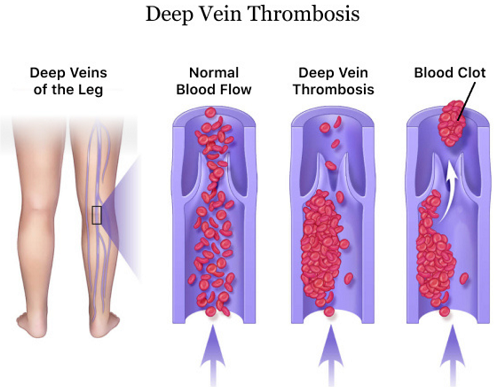Deep Vein Thrombosis (DVT) - Blood Clots in Veins
- Home
- Vascular Treatment
- Deep Vein Thrombosis (DVT) – Blood Clots in Veins

Understanding Deep Vein Thrombosis (DVT)
Deep Vein Thrombosis (DVT) is a medical condition that occurs when a blood clot forms in one of the deep veins, typically in the legs. These clots can restrict blood flow, causing swelling, pain, and other symptoms. DVT is a serious condition because the blood clots in veins can break loose, travel through the bloodstream, and lodge in the lungs, leading to a pulmonary embolism, which can be life-threatening.
Managing DVT
Effective management of DVT involves both preventing new clots from forming and treating the existing clot. Anticoagulant medications, also known as blood thinners, are commonly prescribed to prevent further clotting. Compression stockings can help reduce swelling and pain. In some cases, thrombolytic therapy, which involves the administration of clot-dissolving medications, may be used to break up clots. Regular monitoring and follow-up with a healthcare provider are crucial to ensure the effectiveness of treatment and prevent complications.
Vascular Surgeon in Vadodara (Rutvij Shah)
For those experiencing symptoms or at risk of DVT, consulting a vascular surgeon in Vadodara, such as Rutvij Shah, can provide specialized care. Vascular surgeons are experts in the diagnosis and treatment of conditions affecting the veins and arteries. They can offer personalized treatment plans, including medications, lifestyle changes, and surgical interventions if necessary, to manage DVT effectively and reduce the risk of complications.
In conclusion, Deep Vein Thrombosis (DVT) is a condition where blood clots form in the deep veins, usually in the legs. Managing DVT requires a combination of medications, lifestyle changes, and specialized medical care from a vascular surgeon in Vadodara, like Rutvij Shah, to prevent serious complications and improve overall vascular health.
-
How Common Is Deep Vein Thrombosis (DVT)?
DVT affects about 1 in 1,000 people each year. Certain factors like prolonged immobility, surgery, and genetic predisposition can increase the risk.
-
What Are the Complications of DVT?
The main complication of DVT is pulmonary embolism, which occurs if a clot breaks loose and travels to the lungs. Other complications can include post-thrombotic syndrome, characterized by pain and swelling.
-
What Is the Most Common Cause of DVT?
DVT is commonly caused by factors that impede blood flow, such as prolonged bed rest, surgery, or injury. Other risk factors include inherited blood disorders, hormone therapy, and cancer.
-
When Should I See My Healthcare Provider?
You should see your healthcare provider if you experience symptoms like swelling, pain, or redness in the leg, especially if these symptoms occur suddenly.
-
When Should I Go to the ER?
Seek immediate medical help if you experience shortness of breath, chest pain, or a rapid pulse, as these could be signs of a pulmonary embolism.
